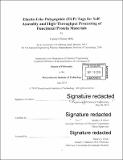Elastin-like polypeptide (ELP) tags for self-assembly and high-throughput processing of functional protein materials
Author(s)
Mills, Carolyn Elaine.
Download1138377091-MIT.pdf (57.70Mb)
Other Contributors
Massachusetts Institute of Technology. Department of Chemical Engineering.
Advisor
Bradley D. Olsen.
Terms of use
Metadata
Show full item recordAbstract
The diverse recognition and catalytic capabilities of globular proteins makes these biomolecules promising candidates in a broad array of applications, including industrial production of commodity chemicals, point-of-care diagnostics, and therapeutics. Self-assembly of globular protein-polymer bioconjugates into nanostructured materials is an attractive protein immobilization strategy that allows for both high protein packing density and control over protein orientation in the material. However, challenges associated with protein-polymer bioconjugate preparation limit the use of these materials in high-throughput processes. This thesis focuses on overcoming this challenge by replacing the polymer block of these bioconjugate materials with a genetically fused elastin-like polypeptide (ELP) tag. The first part of this thesis explores the effects of ELP charge and hydrophobicity on the self-assembly of ELP-mCherry fusion proteins in concentrated solution. Concentrated solution characterization of fusion protein self-assembly showed that the addition of charge to the ELP block decreases the propensity for fusion protein self-assembly. Subsequent dilute solution measurements on the ELPs and ELP/mCherry blends revealed that these ELPs behave similarly to analogous charged polymers, but do not complex with mCherry in dilute solution. This combination of results leads to two main conclusions concerning the self-assembly of ELP-mCherry fusion proteins. First, the addition of charge to the ELP block decreases the preopensity for concentrated solution self-assembly because it reduces the effective repulsion between ELP and mCherry blocks by reducing charge cohesion asymmetry between the two protein blocks. Second, for fusions containing a negatively charged ELP block, repulsion between negatively charged ELPs further weakens self-assembly. The second part of this thesis focused on development of a platform for high-throughput preparation of ELP-fusion materials. One key pitfall of existing ELP-based purification strategies (which can be implemented in high-throughput formats) is that they do not permit control over final protein solution salinity. To overcome this challenge, the existence of ELP cononsolvency in water/alcohol solutions was investigated. This resulted in the discovery and first reports of ELP cononsolvency, as well as the report of upper-critical solution temperature (UCST) transitions of ELPs under certain solvent conditions. Application of ethanol-induced ELP precipitation to desalting of protein materials was then investigated using a model fusion protein of ELP and superfolder green fluorescent protein (ELP-sfGFP). A combination of sodium chloride- and ethanol-induced precipitations was used to reliably purify and desalt ELP-sfGFP in a well-plate format. Finally, this purification procedure was applied to an ELP fusion construct capable of incorporating a library of Sso7d binding proteins with variate streptavidin binding affinity. Two Sso7d variants incorporated into this construct were found to have measurably different binding affinities in both dilute solution and in self-assembled films, demonstrating the capacity of this system to screen self-assembled materials for desired functional protein properties.
Description
Thesis: Ph. D., Massachusetts Institute of Technology, Department of Chemical Engineering, 2019 Cataloged from PDF version of thesis. Includes bibliographical references.
Date issued
2019Department
Massachusetts Institute of Technology. Department of Chemical EngineeringPublisher
Massachusetts Institute of Technology
Keywords
Chemical Engineering.